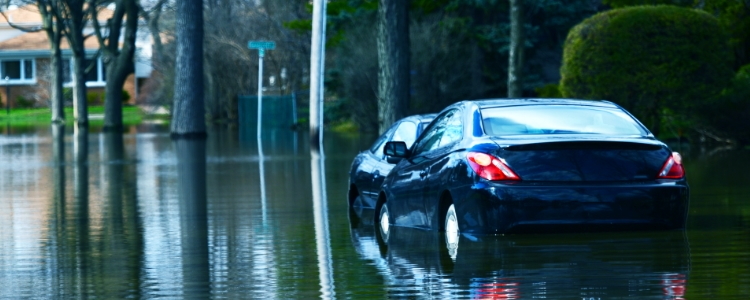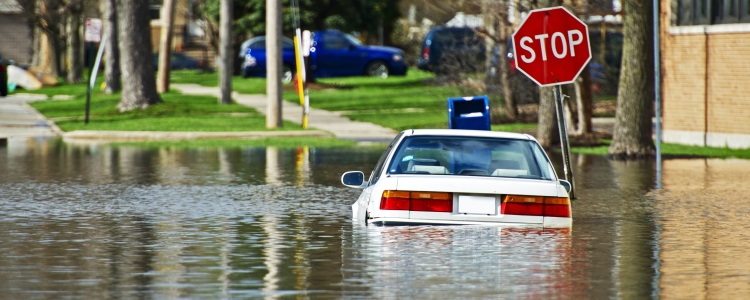Car buyers with damaged credit should be wary of too-good-to-be-true car deals. There's a chance that the vehicle that looks perfect could be flood damaged.
In late March of 2016, Texas and parts of the South-Central U.S. were hit by severe storms that triggered massive flash flooding and hailstorms. Now, these areas are recovering, and the reports are in, showing that the worst losses occurred in Texas, where these weather conditions caused an estimated $600 million worth of insurance claims for damage to automobiles and homes.
The National Insurance Crime Bureau (NICB) reminds consumers to beware of buying flood-damaged vehicles.
Keeping a Watchful Eye on Sales of Flood Damaged Cars
As with all major natural disasters, NICB assists law enforcement agencies, as well as insurance and car rental companies with identifying and cataloging water-damaged vehicles to keep them from being resold to unsuspecting consumers.
Already, authorities estimate that thousands of vehicles may have been flooded. "NICB agents see it time after time. Natural disasters bring out dishonest salvage dealers who don't tell you that the vehicles they're selling are heavily water-damaged," said NICB President and CEO Joe Wehrle. "Consumers need to know that these vehicles may appear advertised for sale without any indication that they were affected by the flooding. As always, buyers should be careful when considering a used vehicle purchase in the weeks and months following a disaster like this."

So, what can car buyers do to protect themselves from falling prey to this deception? First of all, NICB recommends that buyers take advantage of its free online service called VINCheck, which contains vehicle data from insurance companies representing about 88 percent of the personal auto insurance market and lets buyers see whether a vehicle has ever been declared as "salvage" or a total loss. It also alerts users if a vehicle has been stolen and is still unrecovered.
In addition to that, Carfax has some tips on what buyers can do to further ensure that they do not end up with one of these salvaged vehicles.
Always work with a reputable dealer
Keep in mind that the absolute cheapest is not always the best choice. A deal that may look great on paper may only be good on paper. Make sure you are working with a dealership that is known for having great relationships with their customers. As Chris Brewer, a Carfax blogger, states: "Well-established dealerships are not in business for short-term financial profit. If your community has a family-owned dealer that has been in the same location for three decades, there is a good chance they aren't going to risk everything to make a few quick dollars selling misrepresented flood vehicles."
Inspect the interior and exterior of the vehicle
Do a thorough inspection of the car, inside and out.
Inside:
- Unusual odors. Brewer states that "the easiest flood damage test is also the most telling. Close all the windows and doors let the car sit for a few minutes and then crack open the door a take a good sniff. Mildew and mold have a distinct smell, even trace amounts of either one is pretty apparent if the car is sealed. If you have a friend or family member who regularly complains about smells that everyone else seems oblivious to, bring them along." Also, keep your nose on the lookout for any unusually strong good odors: "You should also beware of cars that smell too good, since a spray-on fabric freshener can mask odors."
- Check the upholstery. "Damp spots under the seats are of particular interest; if you can lift the carpet and inspect the padding, even better. While it is easy to dry the carpet's surface, foam or jute padding can retain moisture for years. During your inspection look for previous water damage evidence by blotchy water stains." However, Brewer also notes that "stains do not necessarily mean the vehicle has been in a flood. Any parent of a toddler can attest to that." Also, scrutinize upholstery or carpeting which is loose, new, stained or doesn't match. This includes checking the trunk area as well, especially for standing water.
- Check for rust around doors, under the dashboard, on the pedals or inside the hood and trunk latches.
- Look for mud or silt in the glove compartment or under the seats.
- Check for brittle wires under the dashboard.
- Look for fog or moisture beads in the interior lights or instrument panel.
Outside:
- Check under the hood. Look for any debris that has washed up and deposited itself in the nooks and crannies of the engine, such as leaves, silt and sand. Evidence of this in the engine or spark plug wire cavities is a sure sign something is amiss. Also, Brewer encourages buyers to "check the engine oil by pulling the dipstick. When oil mixes with even a small amount of water it becomes murky, like a melted chocolate milkshake. If the oil looks a little suspicious start the car and check it again, sometimes the water will settle above the oil if the car has been sitting for a while and turning the engine over will whip it all back up into a tell-tale mess," and that "If the vehicle is equipped with a transmission dip stick, check that too."
- Check the air filter. "Most cars only require a few clips to be undone or some screws to be removed to expose the filter. Once paper is wet it never looks the same. Think of it as that little strip in your cellphone that turns pink if you drop it in a puddle. If the filter shows signs of water stains you will want to keep looking for another vehicle."
- Do an overall exterior inspection. Moisture or fogging in the light fixtures could indicate flood damage, or simply a damaged seal. Brewer advises to "get close and inspect for tiny drilled holes that may have been added to drain flood water."
Get the eye of a professional
Before you sign that car loan contract, have the car inspected by an ASE Certified Master Mechanic, as well as a Body Specialist. Whether you suspect that your prospective purchase is a salvaged vehicle, or the vehicle history report (VHR) shows a clean bill of health, the best way to ensure that it is in the best condition possible is by having it looked over by professionals who see this kind of stuff every day.
Take the car on a thorough test drive
Once again, make this a standard practice when you are looking to purchase a vehicle, regardless of suspected flood damage. Check for any strange odors while driving and make certain all features, such as displays and speakers, are working properly.
Don't Let Your Wallet Sink Underwater
The team here at Auto Credit Express has been helping car buyers with damaged credit get connected with a dealer who could finance them for nearly two decades. Our nationwide network of reputable car dealers makes it possible for us to find you a dealer nearest your local area that can help you get approved. Complete our fast, secure and simple online application to get started today.
















